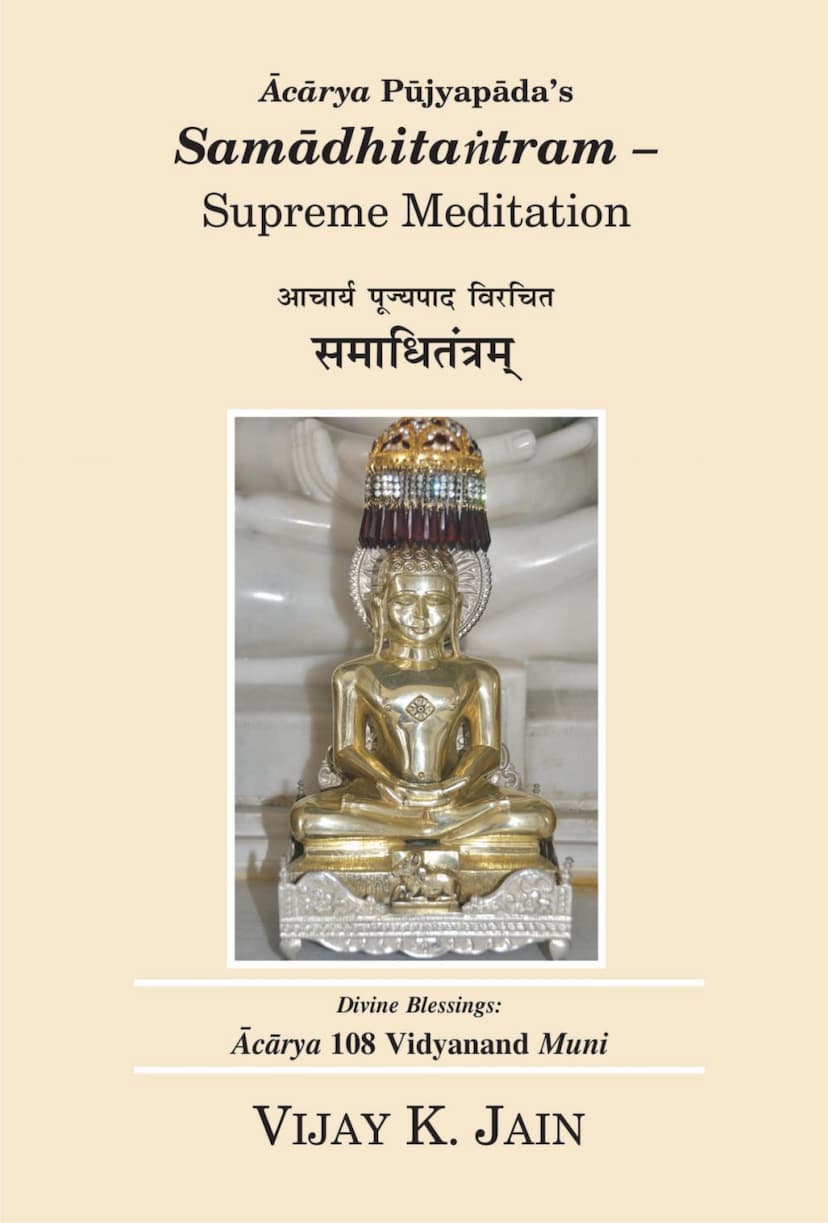Samadhi Tantram
Added to library: September 2, 2025

Summary
The provided text is the English translation and scholarly commentary on the Jain text Samādhitantram by Acharya Pujyapada, compiled and translated by Vijay K. Jain. The book was published in 2017 by Vikalp Printers and is dedicated to Supreme Meditation.
Here's a comprehensive summary of the content presented:
1. Introduction and Divine Blessings:
- The book features divine blessings from Acharya 108 Vidyanand Muni, a prominent Jain scholar and ascetic.
- Acharya Vidyanand highlights Acharya Pujyapada's contributions to Jainism through his works on mind purification (Samadhitantram, Istapadesa), speech purification (Jainendra Vyakarana), and body purification (Arogyashastra).
- He emphasizes that Samadhitantram is a great spiritual text that stresses self-purification and the idea that the soul is its own guru. It defines "Samadhi" as a state free from mental afflictions (ādhi), physical ailments (vyādhi), and external entanglements (upādhi).
2. Jain Epistemology and Core Doctrines:
- The preface introduces fundamental Jain epistemological principles that are crucial for understanding Samadhitantram.
- Anekāntavāda (Non-absolutism): The doctrine that reality has infinite characters and should be viewed from multiple perspectives.
- Syādvāda (Conditional Predications): The logical expression of Anekāntavāda, using the qualifier 'syāt' (in a way) to express truths from specific standpoints. It outlines the seven modes of predication (saptabhangī) to describe reality comprehensively.
- Pramāṇa and Naya: Pramāņa is considered valid knowledge, either direct (kevalajñāna) or indirect (paroksa). Naya represents a partial viewpoint within Pramāņa.
- Dravya, Guņa, and Paryāya: The core ontological concepts of Jainism. Dravya (substance) is the underlying reality that possesses attributes (guņa) and undergoes changes in modes (paryāya).
- Utpāda, Vyaya, and Dhrauvya: Origination, destruction, and permanence are seen as simultaneous and interdependent aspects of substance.
- Niscaya Naya (Transcendental Viewpoint) and Vyavahāra Naya (Empirical Viewpoint): The text explains these two crucial perspectives in Jain philosophy, with Niscaya Naya representing the ultimate truth and Vyavahāra Naya being a practical, conventional viewpoint.
3. Acharya Pujyapada: The Master Composer:
- The book provides a biographical note on Acharya Pujyapada (Devanandi, Jinendrabuddhi), a prominent Digambara Jain ascetic of the 5th century CE.
- He was a renowned grammarian, scholar, and author of significant Jain texts like Jainendra Vyakarana, Sarvarthasiddhi, and Samadhitantram.
- His works are noted for their lucid style and profound spiritual insights, influencing subsequent Jain pontiffs.
- The text mentions his supernatural abilities and his eventual voluntary death by samadhi.
4. Acharya Vidyānanda: On the Path to Attaining the Pure-Soul:
- A biographical note on Acharya Vidyānanda (formerly Kṣullaka Pārśvakīrti varņi), detailing his spiritual journey from a Kṣullaka to a Muni and then an Ācārya.
- It highlights his dedication to ascetic practices, vows, self-denial, and unwavering faith in the soul's true nature.
- His life exemplifies the path to liberation through rigorous spiritual discipline and self-realization.
5. Key Teachings of Samādhitantram (verses 1-105): The bulk of the text is a verse-by-verse explanation of Samādhitantram, focusing on the path to spiritual liberation through self-realization and meditation. Key themes include:
- The Three Souls: Distinguishing between Bahirātmā (extroverted soul, identified with the body and senses), Antarātmā (introverted soul, aware of the soul's true nature and discriminating from the non-soul), and Paramātmā (pure soul, the liberated Siddha). The text emphasizes transcending the Bahirātmā state to realize the Paramātmā through the Antarātmā.
- Identification with the Body: The Bahirātmā wrongly identifies the body, senses, and worldly relationships (son, wife, etc.) as the self, leading to attachment, suffering, and continued transmigration.
- The Nature of the Soul: The soul is eternal, formless, conscious, and distinct from the body and all external substances. It is the source of infinite knowledge, perception, bliss, and strength.
- The Path to Liberation:
- Discrimination (Bheda-vijñāna): Understanding the soul as distinct from the body and all non-soul entities.
- Detachment: Renouncing attachment to worldly objects and the body.
- Meditation (Samādhi): Concentrating the mind on the true nature of the soul, free from external distractions and internal passions (attachment, aversion, delusion).
- Control of Senses and Mind: Withdrawing the senses from external objects and calming the mind.
- Renunciation of Vows: While vows are steps towards purity, ultimate liberation involves transcending even the attachment to vows and actions themselves, focusing solely on the pure nature of the soul.
- Self-Reliance: The soul is its own guru; liberation is achieved through self-effort and self-realization, not through external rituals, symbols, castes, or external dictates.
- The Role of Austerity: Austerity is necessary to burn off karmas, but without the correct understanding of the soul's distinctness, it does not lead to liberation. True spiritual progress comes from internal purification and self-knowledge.
- The Illusory Nature of the World: The external world and its experiences are perceived as either inanimate (Achetan) or incomprehensible to the senses (Adṛśya). True reality (the soul) is invisible to the senses but knowable through self-experience.
- The Importance of Solitude and Calmness: A calm, undisturbed mind, free from the waves of passions and external distractions, is essential for realizing the soul.
- The Fruit of True Meditation: Achieving a state of profound bliss, equanimity, and freedom from the cycle of birth and death.
6. Indexes:
- The book includes comprehensive indexes of:
- Verses (Kārikā)
- Scriptural Excerpts (Shastroddharan)
- Sanskrit Terms (Samkṣipta Śabdāvali)
- Guide to Transliteration (IAST system)
7. Related Publications:
- The back pages list other Jain sacred texts published by Vikalp Printers, translated and edited by Vijay K. Jain, often with forewords by Acharya 108 Vidyanand Muni. These include Tattvärthasūtra, Samayasāra, Puruṣārthasiddhyupāya, Dravyasamgraha, Iṣṭopadeśa, Svayambhūstotra, Āptamīmāṁsā, and Ratnākaraṇḍaka-śrāvakācāra.
In essence, Samādhitantram as presented is a profound guide to achieving spiritual liberation through self-awareness, discrimination between the soul and the non-soul, detachment from worldly illusions, and focused meditation on the true, pure nature of the soul. The commentary by Vijay K. Jain, supported by the blessings of Acharya Vidyānanda Muni, makes these complex teachings accessible to a modern audience.